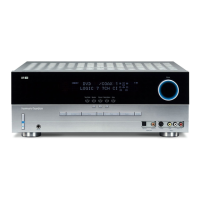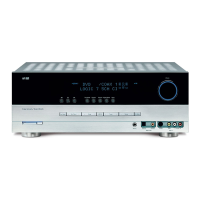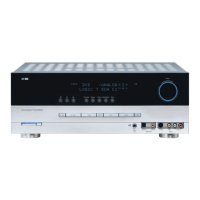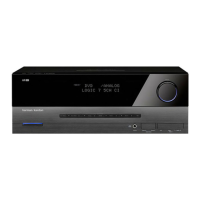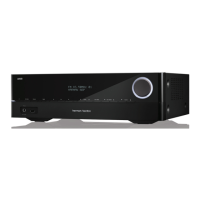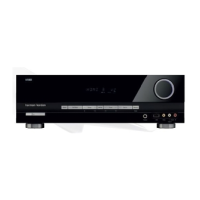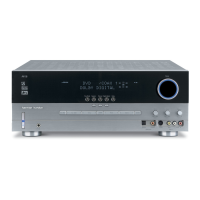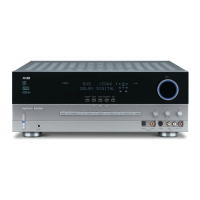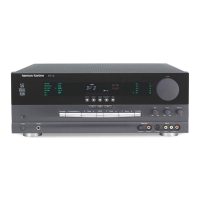Do you have a question about the Harman Kardon AVR 146 and is the answer not in the manual?
| Channels | 5.1 |
|---|---|
| Type | AV Receiver |
| Input impedance | 47kΩ |
| Input sensitivity | 200mV |
| Signal-to-noise ratio | 100dB |
| HDMI outputs | 1 |
| Digital audio inputs (optical) | 2 |
| Digital audio inputs (coaxial) | 1 |
| Component video inputs | 2 |
| Component video outputs | 1 |
| Composite video inputs | 3 |
| Composite video outputs | 1 |
| Video Outputs | 2 |
| Output Connections | Composite Video |
| Surround mode power | 50W per channel |
| Frequency Response (20Hz-20kHz) | 20Hz-20kHz |
| Total Harmonic Distortion (0.7%) | 0.7% |
| Signal-to-Noise Ratio (80dB) | 80dB |
| Total Harmonic Distortion | <0.7% THD |
Prominent warnings regarding electric shock and opening the unit.
Numbered safety instructions covering operation, cleaning, and environment.
Advice on placement, ventilation, handling, cleaning, and moving procedures.
FCC compliance information and unpacking instructions.
Introduction to Harman Kardon and the AVR 146 receiver's main features.
Lists audio capabilities and available surround sound modes.
Details on connection types, on-screen display, and remote features.
List of items included with the AVR 146 receiver.
Explanation of front panel buttons for power, display, source selection, tuning, and volume.
Description of surround mode selection and speaker indicators.
Guidance on connecting antennas, speakers, and subwoofer to rear terminals.
Details on various audio and video input/output jacks for source devices.
Explanation of component and HDMI video connections.
How to operate the remote, select sources, and basic functions like power and mute.
Using the remote to control the AVR, adjust volume, and select audio modes.
Controls for setup, tuning, navigation, macros, and punch-through.
Explanation of home theater setup and multichannel audio.
Categorization of various surround sound modes available.
Guide for cable color coding and speaker terminal types.
Instructions for connecting subwoofers and various source components.
Details on digital, analog, multichannel audio, and The Bridge connection.
Explanation of HDMI, analog video, and antenna connections.
Recommendations for speaker placement in a room for best sound.
Overview of installation steps including connecting speakers, subwoofer, antennas, and sources.
Table detailing recommended connections for various source devices.
Instructions for connecting Video 1, 2, 3, DVD, and 6-Channel sources.
Guidance on connecting HDMI, CD, Tape devices, and The Bridge accessory.
Step Five: Connecting the receiver to the TV or video display.
Connecting video outputs to display and plugging in AC power.
Inserting batteries and initial remote programming.
Detailed steps for programming remote control codes for external devices.
Step-by-step instructions for the initial power-on sequence.
How to use the OSD for system configuration.
Step One: Identifying speaker capabilities for setup.
Step Two: Measuring speaker distances for delay adjustments.
Step Three: Accessing manual setup and configuring speaker sizes.
Detailed settings for speaker size and crossover frequency.
Setting crossover points and adjusting speaker delay times.
Compensating for audio/video synchronization issues.
Step Four: Calibrating speaker output levels for balanced sound.
Configuring test tone sequences and channel settings.
Step Five: Assigning audio/video inputs to specific sources.
Configuring iPod playback settings via The Bridge.
Procedures for powering on the receiver and using the sleep timer.
Adjusting volume levels and temporarily muting audio output.
Adjusting tone settings and using headphones.
How to select audio/video sources and manage input assignments.
Selecting specific audio and video inputs for each source device.
How to connect and use multichannel audio sources via 6-Channel Direct Inputs.
Operating the AM/FM tuner, tuning modes, and storing presets.
Instructions and notes for recording audio and video signals.
Operating an iPod connected via The Bridge accessory.
How to select and cycle through available surround sound modes.
Explanation of audio processing, analog vs. digital signals, and surround capabilities.
Details on Analog Bypass, DSP Surround Off, and Analog Surround Modes.
How digital audio signals work and selecting surround modes via OSD.
Introduction to Dolby Surround settings and their categories.
Detailed settings for Center Width, Dimension, Panorama, and Night Mode.
Configuring upsampling and default surround mode behavior.
Detailed descriptions of Dolby surround modes and their applicable signals.
Detailed descriptions of DTS, Logic 7, Hall, Theater, Stereo modes.
Adjusting display timeouts, volume defaults, and OSD background.
Dimming the display and overview of advanced remote functions.
Programming punch-through controls and macros for the remote.
How to reset the remote and the AVR processor to factory defaults.
Information on how user settings are retained during power outages.
Solutions for common problems like no power, no sound, or display issues.
Solutions for tuner interference, remote command issues, and signal problems.
Detailed technical specifications for audio, tuner, and video sections.
Information on power, dimensions, weight, and product trademarks.
Tables providing default settings for sources, speakers, and delays.
Worksheets for recording source input and speaker/channel settings.
Tables listing remote control codes and default system settings.
Comprehensive list of remote button functions for various devices.
Continuation of the remote control function list.
Table of remote control codes for TV manufacturers.
Table of remote control codes for VCR manufacturers.
Tables of remote control codes for CD and DVD players.
Tables of remote control codes for SAT, TAPE, and CBL manufacturers.
Continuation of CBL codes and codes for The Bridge/DMP.
